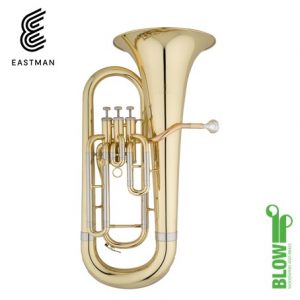

Professional models have three top-action valves, played with the first three fingers of the right hand, plus a "compensating" fourth valve, generally found midway down the right side of the instrument, played with the left index finger such an instrument is shown in the above picture. In continental European music, parts for the euphonium are sometimes written in the bass clef a major second higher than sounding. It can also be written in tenor clef at concert pitch, which is usually done to prevent too many ledger lines in case it is a high part. In the British-style brass band tradition, euphonium music is always written this way. In North America, music for the instrument is usually written in the bass clef at concert pitch (that is, without transposition), though treble clef euphonium parts, transposing down a major ninth, are included in much concert band music¹. The euphonium is pitched in concert B-flat music|♭, meaning that when no valves are in use the instrument will produce partials of the B-flat harmonic series. The euphonium is a valved instrument nearly all current models are piston valved, though rotary valved models do exist.Ī person who plays euphonium is sometimes called a "euphoniumist" or a "euphonist", while British players often colloquially refer to themselves as "euphists." Similarly, the instrument itself is sometimes referred to as "eupho" or "euph". It derives its name from the Greek word "euphonos", meaning "beautiful-sounding" or "sweet-voiced" ("eu" means "well" or "good" and "phonium" means "voice").


The euphonium is a conical-bore, baritone-voiced brass instrument.


 0 kommentar(er)
0 kommentar(er)
